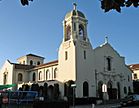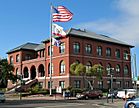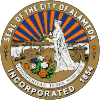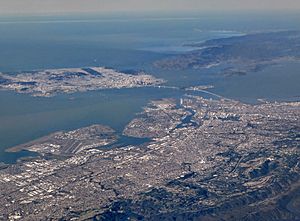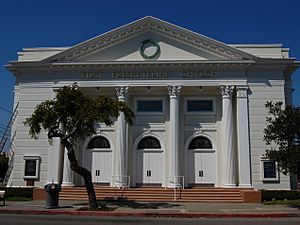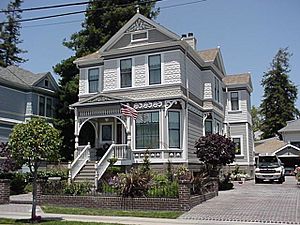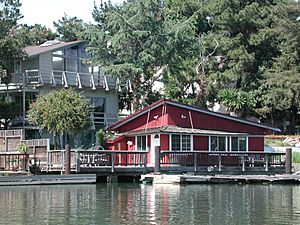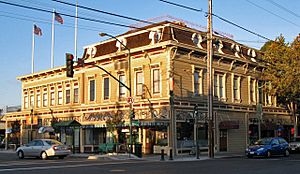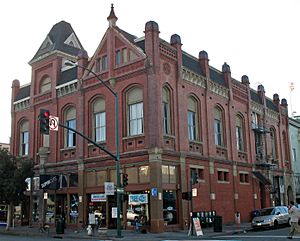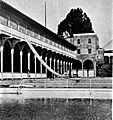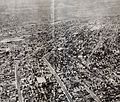Alameda, California facts for kids
Quick facts for kids
Alameda, California
|
|||
|---|---|---|---|
| City of Alameda | |||
|
Clockwise from top left: Basilica of St. Joseph, Alameda; Alameda City Hall; Twin Towers Methodist Church; Alameda High School.
|
|||
|
|||
| Nickname(s):
The Island City
|
|||

Location in Alameda County
and the state of California |
|||
| Country | United States | ||
| State | California | ||
| County | Alameda | ||
| Founded Incorporated |
June 6, 1853 March 7, 1872 |
||
| Government | |||
| • Type | Council–manager | ||
| Area | |||
| • Total | 22.98 sq mi (59.52 km2) | ||
| • Land | 10.45 sq mi (27.06 km2) | ||
| • Water | 12.53 sq mi (32.45 km2) 53.79% | ||
| Elevation | 33 ft (10 m) | ||
| Population
(2020)
|
|||
| • Total | 78,280 | ||
| • Density | 7,491.63/sq mi (2,892.62/km2) | ||
| Demonyms | Alamedan | ||
| Time zone | UTC−8 (Pacific) | ||
| • Summer (DST) | UTC−7 (PDT) | ||
| ZIP Codes |
94501–94502
|
||
| Area code | 510, 341 | ||
| FIPS code | 06-00562 | ||
| GNIS feature IDs | 277468, 2409669 | ||
Alameda ( AL-ə-MEE-də; Spanish for "tree-lined path") is a city in Alameda County, California, located in the East Bay region of the Bay Area. The city is primarily located on Alameda Island, but also spans Bay Farm Island and Coast Guard Island, as well as a few other smaller islands in San Francisco Bay. The city's estimated population in 2019 was 77,624.
Contents
History
The island Alameda occupies what was originally a peninsula connected to Oakland. Much of it was low-lying and marshy, but on higher ground than the peninsula and adjacent parts of what is now downtown Oakland were home to one of the largest coastal oak forests in the world. The area was therefore called Encinal, Spanish for "forest of evergreen oak". Alameda is Spanish for "grove of poplar trees" or "tree-lined avenue", and was chosen in 1853 by popular vote.
The inhabitants at the time of the arrival of the Spanish in the late 18th century were a local band of the Ohlone tribe. The peninsula became part of the vast Rancho San Antonio granted in 1820 to Luis Peralta by the Spanish king who claimed California. The grant was later confirmed by the new Republic of Mexico upon its independence from Spain.
Over time, the place became known as Bolsa de Encinal or Encinal de San Antonio.
The city was founded on June 6, 1853, and the town originally contained three small settlements. "Alameda" referred to the village at Encinal and High Streets, Hibbardsville was at the North Shore ferry and shipping terminal, and Woodstock was on the west near the ferry piers of the South Pacific Coast Railroad and the Central Pacific. Eventually, the Central Pacific's ferry pier became the Alameda Mole, featuring transit connections between San Francisco ferries, local trollies and Southern Pacific (formerly Central Pacific) commuter lines.
The first post office opened in 1854. The first school, Schmermerhorn School, was opened in 1855 (and eventually became Lincoln School), Encinal School was opened in 1860 (and closed in 1980). The San Francisco and Alameda Railroad opened the Encinal station in 1864. The Encinal area was also known as Fasskings Station in honor of Frederick Louis Fassking. Encinal's own post office opened in 1876, was renamed West End in 1877, and closed in 1891. The West End area was originally called Bowman's Point in honor of Charles G. Bowman, an early settler.
The Alameda Terminal was the site of the arrival of the first train via the First Transcontinental Railroad into the San Francisco Bay Area on September 6, 1869. The transcontinental terminus was switched to the Oakland Mole two months later, on November 8, 1869.
The borders of Alameda were made coextensive with the island in 1872, incorporating Woodstock into Alameda. Mark Twain described Alameda as being "The Garden of California."
In 1917, an attraction called Neptune Beach was built in the area now known as Crab Cove. Often compared to Coney Island, the park was a major attraction in the 1920s and 1930s. The original owners of the facility, the Strehlow family, partnered with a local confectioner to create tastes unique to Neptune Beach. Both the American snow cone and the popsicle were first sold at Neptune Beach. The Kewpie doll, hand-painted and dressed in unique hand-sewn dresses, became the original prize for winning games at the beach – another Neptune Beach invention. The Strehlows owned and operated the beach on their own, even filling in a section of the bay to add an additional Olympic-size swimming pool and an exceptional roller coaster which must have given riders a tremendous view of the bay. The Cottage Baths were available for rent.
Neptune Beach's two huge outdoor pools hosted swimming races and exhibitions by such famous swimmers as Olympian Johnny Weissmuller, who later starred as the original Tarzan, and Jack LaLanne, who started a chain of health clubs. The park closed down in 1939 because of the Great Depression, the completion of the San Francisco–Oakland Bay Bridge, people circumventing paying the admission price, and the rise of car culture. Once the Bay Bridge was complete, the rail lines, which ran right past the entrance to Neptune Beach on the way to the Alameda Mole and the Ferry, lost riders in droves. People began using their cars to escape the city and the immediate suburbs like Alameda and traveling further afield in California. Alameda lost its resort status as more distant locations became more attractive to cash-rich San Francisco tourists. Youngsters in town became aware of ways to avoid paying the dime for admission to the park. Strong swimmers or even waders could sneak in on the bay side just by swimming around the fence.
Some of the resort homes and buildings from the Neptune beach era still exist in present-day Alameda. The Croll Building, on the corner of Webster Street and Central Avenue, was the site of Croll's Gardens and Hotel, famous as training quarters for some of the greatest fighters in boxing history from 1883 to 1914. James J. Corbett, Bob Fitzsimmons, Jim Jefferies, Jack Johnson, and many other champions all stayed and trained here. Today this beautifully preserved building is home to Croll's Pizza and the 1400 Bar & Grill Restaurant. Neptune Court, just a block away on the corner of Central Ave. and McKay Ave., provides another glimpse of what resort life was like in Alameda in the 1920s. A short walk near Crab Cove will reveal many more historic gems.
The vast majority of the Neptune Beach structures – the hand-carved carousel from the world-famed Dentzel Company, the Ferris wheel, the roller coaster, and other rides – were auctioned off in 1940 for mere pennies on the dollar of their original cost. Today, A consequence of the Neptune Beach closing around 1940 was a total dearth of quality, clean swimming facilities in town. A grass roots effort to create swimming pools at two high schools and two city parks would continue into the early 1960s.
When the railroad came to town in the 1860s Park Street developed into the major thoroughfare of the city and the location of the main Alameda train station, residents of Old Alameda pulled up stakes and moved across town to the new downtown. The street's location was chosen by two landowners who wished to attract tenants and development to their land. As a result, they designated their mutual property line as Park Street.
In 1902, the need for expanded shipping facilities led to the dredging of a canal through the marshland between Oakland and Alameda, turning Alameda into an island. Most of the soil from the canal was used to fill in nearby marshland. The area of Alameda called Bay Farm Island is no longer an island, but is attached by fill to Oakland. In his youth, author Jack London was known to take part in oyster pirating in the highly productive oyster beds near Bay Farm Island, today long gone. The Alameda Works Shipyard was one of the largest and best equipped shipyards in the country. In the 1950s, Alameda's industrial and ship building industries thrived along the Alameda Estuary, where the world's first-ever, land-based, containerized shipping crane was used. Today, the Port of Oakland across the estuary serves as one of the largest ports on the West Coast, using the shipping technologies originally experimented with in Alameda. As of March 21, 2006, Alameda is a "Coast Guard City", one of seven in the country.
In addition to the regular trains running to the Alameda Mole, Alameda was also served by local steam commuter lines of the Southern Pacific (initially, the Central Pacific) which were later transformed into the East Bay Electric Lines. Southern Pacific's electrified trains were not streetcars, but full-sized railroad cars which connected to the mainland by bridges at Webster Street and Fruitvale (only the latter bridge survives today). The trains ran to both the Oakland Mole and the Alameda Mole. In fact, one line which ran between the two moles was dubbed the "Horseshoe Line" for the shape of the route on a map. Soon after the completion of the Bay Bridge, Alameda trains ran directly to San Francisco on the lower deck of the bridge, the ferries having been rendered unnecessary. Alameda was the site of the Southern Pacific's West Alameda Shops where all the electric trains were maintained and repaired.
In the 1930s Pan American Airways established a seaplane port along the fill that led to the Alameda Mole. This was the original home base for the famous China Clipper flying boat. In 1929, the University of California established the San Francisco Airdrome located near the current Webster Street tube as a public airport. The Bay Airdrome had its gala christening party in 1930. The airfield was a busy place, as an early home base for Coastal Air Freight, Varney Air Lines, West Coast Air Transport, Western Air Express, the transbay Air Ferries, and Boeing's Pacific Air Transport. The Airdrome was closed in 1941 when its air traffic interfered with the newly built Naval Air Station Alameda (NAS Alameda). With the advent of World War II, a vast stretch of the marshy area southwest of the Alameda Mole was filled and the NAS Alameda established. This major Naval facility included a large airfield, as well as docks for several aircraft carriers. It closed in 1997.
In the late 1950s the Utah Construction Company began a landfill beyond the Old Sea Wall and created South Shore.
1973 air disaster
On February 7, 1973, a USN Vought A-7E Corsair II fighter jet on a routine training mission from Lemoore Naval Air Station, suddenly caught fire, 28,000 feet over the San Francisco Bay and crashed into the Tahoe Apartments in Alameda. Eleven people, including pilot Lieutenant Robert Lee Ward died in the crash and fire.
Geography
According to the United States Census Bureau, the city has a total area of 23.0 square miles (60 km2), of which 10.6 square miles (27 km2) is land and 12.3 square miles (32 km2) (53.79%) is water.
Although Alameda's nickname is "The Island City" (or simply "the island"), the current city occupies two islands as well as a small section of the mainland. Today, the city consists of the main original section, with the former Naval Air Station Alameda (NAS Alameda) at the west end of Alameda Island, Southshore along the southern side of Alameda Island, and Bay Farm Island, which is part of the mainland proper. The area of the former NAS is now known as "Alameda Point." The Southshore area is separated from the main part of Alameda Island by a lagoon; the north shore of the lagoon is located approximately where the original south shore of the island was. Alameda Point and Southshore are built on bay fill.
Not all of Alameda Island is part of the City of Alameda. Although nearly all of the island is in Alameda city limits, a small portion of a dump site west of the former runways at Alameda Point extends far enough into San Francisco Bay that it is over the county line and part of the City and County of San Francisco.
Coast Guard Island, a small island between Alameda Island and Oakland, is also part of Alameda and is the home of Integrated Support Command Alameda
Climate
This region experiences warm (but not hot) and dry summers, with no average monthly temperatures above 71.6 °F. According to the Köppen climate classification system, Alameda has a warm-summer Mediterranean climate, abbreviated "Csb" on climate maps. Annual precipitation is about 20 inches, all rain (snow is extremely rare at sea level in the San Francisco Bay area).
Demographics
| Historical population | |||
|---|---|---|---|
| Census | Pop. | %± | |
| 1860 | 460 | — | |
| 1870 | 1,557 | 238.5% | |
| 1880 | 5,708 | 266.6% | |
| 1890 | 11,165 | 95.6% | |
| 1900 | 16,464 | 47.5% | |
| 1910 | 23,383 | 42.0% | |
| 1920 | 28,806 | 23.2% | |
| 1930 | 35,033 | 21.6% | |
| 1940 | 36,256 | 3.5% | |
| 1950 | 64,430 | 77.7% | |
| 1960 | 63,855 | −0.9% | |
| 1970 | 70,968 | 11.1% | |
| 1980 | 63,852 | −10.0% | |
| 1990 | 76,459 | 19.7% | |
| 2000 | 72,259 | −5.5% | |
| 2010 | 73,812 | 2.1% | |
| 2020 | 78,280 | 6.1% | |
| U.S. Decennial Census | |||
2010
The 2010 United States Census reported that Alameda had a population of 73,812. (2015 census estimates place the population at 78,630)
The population density was 3,214.9 people per square mile (1,241.3/km2). The racial makeup of Alameda was 37,460 (50.8%) White, 23,058 (31.2%) Asian, 4,759 (6.4%) African American, 426 (0.6%) Native American, 381 (0.5%) Pacific Islander, 2,463 (3.3%) from other races, and 5,265 (7.1%) from two or more races. Hispanic or Latino of any race were 8,092 persons (11.0%).
The Census reported that 72,316 people (98.0% of the population) lived in households, 857 (1.2%) lived in non-institutionalized group quarters, and 639 (0.9%) were institutionalized.
There were 30,123 households, out of which 9,144 (30.4%) had children under the age of 18 living in them, 13,440 (44.6%) were opposite-sex married couples living together, 3,623 (12.0%) had a female householder with no husband present, 1,228 (4.1%) had a male householder with no wife present. There were 1,681 (5.6%) unmarried opposite-sex partnerships, and 459 (1.5%) same-sex married couples or same-sex partnerships. 9,347 households (31.0%) were made up of individuals, and 2,874 (9.5%) had someone living alone who was 65 years of age or older. The average household size was 2.40. There were 18,291 families (60.7% of all households); the average family size was 3.06.
The age distribution of the population shows 15,304 people (20.7%) under the age of 18, 5,489 people (7.4%) aged 18 to 24, 21,000 people (28.5%) aged 25 to 44, 22,044 people (29.9%) aged 45 to 64, and 9,975 people (13.5%) who were 65 years of age or older. The median age was 40.7 years. For every 100 females, there were 91.7 males. For every 100 females age 18 and over, there were 88.5 males.
Per capita annual income (in 2013 dollars) in 2009–2013 was $41,340 per the US Census. Median household income in 2009–2013 was $74,606 per the US Census.
There were 32,351 housing units at an average density of 1,409.0 per square mile (544.0/km2), of which 30,123 were occupied, of which 14,488 (48.1%) were owner-occupied, and 15,635 (51.9%) were occupied by renters. The homeowner vacancy rate was 1.1%; the rental vacancy rate was 5.7%. 37,042 people (50.2% of the population) lived in owner-occupied housing units and 35,274 people (47.8%) lived in rental housing units.
2000
As of the census of 2000, there were 72,259 people, 30,226 households, and 17,863 families residing in the city. The population density was 2,583.3/km2 (6,693.4/mi2). There were 31,644 housing units at an average density of 1,131.3/km2 (2,931.2/mi2). The racial makeup of the city was 56.95% White, 6.21% Black or African American, 0.67% Native American, 26.15% Asian, 0.60% Pacific Islander, 3.29% from other races, and 6.13% from two or more races. 9.31% of the population were Hispanic or Latino of any race.
There were 30,226 households, out of which 27.7% had children under the age of 18 living with them, 43.7% were married couples living together, 11.4% had a female householder with no husband present, and 40.9% were non-families. Of all households, 32.2% were made up of individuals, and 9.4% had someone living alone who was 65 years of age or older. The average household size was 2.35 and the average family size was 3.04.
In the city, the age distribution of the population shows 21.5% under the age of 18, 7.0% from 18 to 24, 33.6% from 25 to 44, 24.6% from 45 to 64, and 13.3% who were 65 years of age or older. The median age was 38 years. For every 100 females, there were 92.3 males. For every 100 females age 18 and over, there were 89.5 males.
The median income for a household in the city was $56,285, and the median income for a family was $68,625. Males had a median income of $49,174 versus $40,165 for females. The per capita income for the city was $30,982. About 6.0% of families and 8.2% of the population were below the poverty line, including 11.4% of those under age 18 and 6.1% of those age 65 or over.
There is a large Filipino community; and also a major Portuguese community, from which Tom Hanks' mother came and where Lyndsy Fonseca was raised for some time. Alameda also has a historic Japanese American community and had a small Japanese business district on a portion of Park Street before World War II, when the city's Japanese population was interned. A Japanese Buddhist church is one of the few remaining buildings left of Alameda's pre-war Japanese American community.
Transportation
Vehicle access to Alameda Island is via three bridges from Oakland (Park Street, Fruitvale Avenue, and High Street Bridges), as well as the two one-way Posey and Webster Street Tubes leading into Oakland's Chinatown. Connections from Alameda to Bay Farm Island are provided via the Bay Farm Island Bridge for vehicular traffic as well as the Bay Farm Island Bicycle Bridge (the only pedestrian/bicycle-only drawbridge in the United States).
California State Route 61 runs down city streets from the Posey and Webster Street Tubes, across the Bay Farm Island Bridge, and south to the Oakland Airport. The island is just minutes off Interstate 880 in Oakland. The speed limit for the city is 25 mph (40 km/h) on almost every road.
Public transportation options include:
- AC Transit buses, which range from local connections to Oakland and Berkeley to express service to San Francisco
- Ferry services – In addition to the Alameda/Oakland Ferry and the Alameda Harbor Bay Ferry routes, San Francisco Bay Ferry also provides service between Alameda Main Street Station and South San Francisco. All ferry services are operated by the Water Transit Authority.
- The closest BART stations are Lake Merritt and 12th Street, near the exit to the Posey Tube, and Fruitvale, near the Fruitvale Bridge. BART's long-term plans for a second tunnel include Alameda as a candidate for the first stop on a new East Bay line.
Attractions
Due to its proximity to the Bay, wind surfers and kite surfers can often be seen at Robert W. Crown Memorial State Beach. From the beach there are also views of the San Francisco skyline and the San Francisco–Oakland Bay Bridge.
The aircraft carrier USS Hornet, a museum ship, has been moored at the former Naval Air Station as the USS Hornet Museum since 1998. This ship was originally named the USS Kearsarge, but was renamed in honor of the previous Hornet CV-8 (famous for the Doolittle raid), which was lost in October 1942.
Alameda is known for its Victorian houses; 9% of all single-family houses (1500) in Alameda are Victorian, and many more have been divided into two to four-unit dwellings. It is said that Alameda has more pre-1906 earthquake era homes in the Gold Coast section than any other city in the Bay Area.
Alameda is home to the official offices and training facility of the Oakland Raiders American football team, which is located on Bay Farm Island. The facility is also home to The Raider Image, the merchandise arm of the franchise, which the public can visit.
At the turn of the 19th century, the city of Alameda took a large chunk of Charles Froling's land away to build a street. Froling had planned to build his dream house on the plot of land he received through inheritance. To spite the city and an unsympathetic neighbor, Froling built a house 10 feet (3.0 m) wide, 54 feet (16 m) long and 20 feet (6.1 m) high on the tiny strip of land left to him. The Froling spite house is still standing and occupied.
Alameda is also known for its Fourth of July parade, which is advertised as the second oldest and second longest Fourth of July parade in the United States. It features homemade floats, classic cars, motorized living room furniture, fire-breathing dragons, marching bands, and large crowds. The parade route is about 3 miles (5 km) long.
The Historic Park Street Business District is known for its many buildings that date back to the 1800s and is a designated Historic Commercial District on the National Register. This main thoroughfare of downtown Alameda Is filled with local shops, restaurants, drinking establishments, and services. The renovated 1932 Alameda Theatre & Cineplex is the cultural centerpiece of the commercial district. In addition, popular attractions include High Scores Arcade Museum (a retro video game arcade) and Subpar Miniature Golf (an indoor miniature golf complex that features Bay Area landmarks such as the Golden Gate Bridge and Coit Tower at each hole).
Economy
Naval Air Station Alameda (NAS) which was decommissioned in 1997, has been turned over to the City of Alameda for civilian development, today known as Alameda Point.
Following the exit of the former Oakland Raiders, the Oakland Roots of the USL Championship have a license agreement for the former Raiders performance center with the City of Oakland and the County of Alameda.
A cluster of artisan distilleries, wineries, breweries and tasting rooms along Monarch Street at Alameda Point is now referred to by the City of Alameda as "Spirits Alley". These business include Rock Wall Winery, Building 43 Winery, Hangar 1, St. George Spirits and Faction Brewing. In 2017, Admiral Maltings opened at Alameda Point. Designed to supply craft brewers and whisky producers, it is the first craft malting house in California.
The aircraft carrier USS Hornet, a museum ship, has been moored at the former Naval Air Station as the USS Hornet Museum since 1998.
- Top employers
According to the city's 2020 Comprehensive Annual Financial Report, the top employers in the city are:
| # | Employer | # of Employees |
|---|---|---|
| 1 | Penumbra Inc. | 1,839 |
| 2 | Alameda Unified School District | 1,068 |
| 3 | Alameda Hospital | 750 |
| 4 | Abbott Diabetes Care Inc. | 565 |
| 5 | City of Alameda | 543 |
| 6 | Kaiser Foundation Health Plan | 450 |
| 7 | U.S. Department of Transportation | 370 |
| 8 | Alameda Alliance For Health | 366 |
| 9 | Bay Ship & Yacht Co. | 316 |
| 10 | College of Alameda | 266 |
Services
Alameda Hospital is located there.
Alameda Municipal Power
Unlike surrounding communities, Alameda has a municipal power service, Alameda Municipal Power (AMP), that delivers services directly to consumers. AMP sold the majority of its telecommunications business to Comcast in 2008 but continues to provide telecommunication service at Alameda Point.
During the California electricity crisis of 2000 and 2001, Alameda Municipal Power did not raise electricity rates, while residents in most of the state endured significant price increases.
Arts and culture
The Alameda Arts Council (AAC) serves as the local Alameda City arts council. The Alameda Civic Ballet is the ballet troupe of the city. The Alameda Museum features displays on the history of Alameda. The Alameda Art Association has about 80 members as of January 2011, and has a gallery space at South Shore Center mall. The Association began in 1944. An annual benefit, Circus for Arts in the Schools, was started by clown artist Jeff Raz in 2004. Photo-realist Robert Bechtle has painted numerous Alameda subjects, including "Alameda Gran Torino", which was acquired by SFMOMA in 1974 and remains one of Bechtle's most famous works.
Films shot in Alameda
Alameda has been home to many movie sets. Some of the movies filmed on the island have included Bicentennial Man, The Net, The Matrix Reloaded, The Matrix: Revolutions, Bee Season, the original 1968 Your, Mine and Ours and the movie musical Rent. Parts of Alameda High School were animated for the Animatrix episode "Kid's Story". A massive hangar at the former Naval Air Station Alameda was used to film special scenes requiring computer-generated imagery for movies such as Bicentennial Man, Flubber, What Dreams May Come, Mission: Impossible II and many scenes from the Matrix trilogy, including the signature bullet time scene. The open space of the decommissioned naval base often hosts MythBusters' more dangerous experiments. The movie "Spirit Of '76" was filmed all throughout Alameda.
The USS Hornet Museum, permanently moored at Alameda Point, has been the site for scenes used in major theatrical releases: ', Rescue Dawn, and The Master. In addition, the aircraft carrier has been used for television shows such as JAG, Carrier, Looking, The Great Escape, and the special military episode of Fear Factor; plus a number of television commercials.
The Altarena Playhouse
The Altarena Playhouse, which performs comedies, dramas and musicals, was founded in 1938 and is the longest continuously operating community theater in the San Francisco Bay Area.
Rhythmix Cultural Works (RCW) brings people of all ages together to experience and explore music, dance, visual art and educational opportunities. RCW's programs are housed in a restored industrial waterfront building that speaks to Alameda’s history while creating an inclusive venue that reflects the Bay Area’s rich diversity. The organization offers an array of arts programming to the community including Island Arts, Island City Waterways, Round the World Festival and its Performance Art and Learning program (PAL) that serves more than 2000 youth with free cultural arts assemblies each year.
Festivals on Webster Street
Webster Street in Alameda has long been the host of many arts, crafts and holiday festivals. During some of these festivals, the Chamber of Commerce along with the West Alameda Business Association (WABA) will block of a portion of Webster St. for the entertainment of festival goers. Festivals such as The JAM at Neptune Beach formerly known as the Peanut Butter Jam Festival brings a lot of local and outside visitors. Other event on the "West-End" include Trick-or-Treat on Webster Street where merchants supply goodies for local children and culminates with a parade and costume contest; in December "Santa Claus Meet-n-Greet on Webster Street" happens with elves, and a photo with the big guy.
Festivals on Park Street
There are three major events when the street in Alameda's historic downtown district is closed to vehicular traffic. The Park Street Spring Festival takes place every May during the weekend of Mother's Day and attracts over 50,000 visitors. The Park Street Art & Wine Faire takes place the last weekend of every July and attracts over 100,000 visitors. Both street fairs feature over 150 arts & crafts vendors, food vendors, beer and wine pouring, a children's area, and two stages with regional entertainment. The Park Street Classic Car Show is held on the second Saturday every October and displays over 400 vintage vehicles.
Sister cities
Alameda's relationships with Wuxi and Jiangyin were initiated in 2005, in part, by Stewart Chen, who then served on the City of Alameda Social Service and Human Relations board, and who went on to be elected to Alameda City Council in November, 2012.
Wuxi, China, is a so-called friendship city, because the diplomacy organization Sister Cities International does not recognize the relationship.
 Jiangyin, China
Jiangyin, China Arita, Japan
Arita, Japan Lidingö, Sweden. Initiated in 1959 as part of President Eisenhower's people-to-people-movement, whose purpose was to develop better understanding among people from different countries after World War II. Both Alameda and Lidingö are islands with a bridge connecting them to a big city.
Lidingö, Sweden. Initiated in 1959 as part of President Eisenhower's people-to-people-movement, whose purpose was to develop better understanding among people from different countries after World War II. Both Alameda and Lidingö are islands with a bridge connecting them to a big city. Dumaguete City of Negros Oriental, Philippines
Dumaguete City of Negros Oriental, Philippines
Friendship city
 Wuxi, China (Friendship city since 2004)
Wuxi, China (Friendship city since 2004)
Education

Public primary and secondary education in Alameda is the responsibility of the Alameda Unified School District, which is legally separate from the City of Alameda government (as is common throughout California). The College of Alameda, a two-year community college in the West End is part of the Peralta Community College District. The city has numerous private primary schools, and one private high school, St. Joseph Notre Dame High School, a Catholic school.
Notable people
- Albert Arents, a mining engineer who helped develop mineral resources of the Rocky Mountains.
- John Baker, MLB catcher for San Diego Padres and Chicago Cubs, was born in Alameda.
- Shirley Temple Black, actress and former U.S. ambassador
- Mike Brisiel, an offensive guard for Oakland Raiders.
- Virginia Lee Burton, Caldecott-winning children's author and illustrator.
- Harold Camping, television and radio personality, president and general manager of Family Stations, Inc.
- Phyllis Diller, television comedian, attended Sunday school at First Presbyterian, married and lived in Alameda at the start of her comedy act in San Francisco in the 1950s.
- General James Doolittle, who received the Medal of Honor for his bombing of Japan during World War II; Doolittle was born in Alameda in 1896.
- Garrett Eckbo, landscape architect who lived in Alameda as a child, later forming the Bay Area firm of Eckbo, Royston, Williams with Robert Royston and Edward Williams.
- Leif Erickson, actor, born in Alameda in 1911.
- Larry Eustachy, college basketball coach, born in Alameda.
- Debbi Fields, founder of Mrs. Fields Cookies, attended Alameda High School, where she was a cheerleader.
- Albert Ghiorso, nuclear scientist, co-discoverer of 12 chemical elements on the periodic table; in Guinness Book of World Records for Most Elements Discovered.
- Brad Gillis, guitarist with Night Ranger, a San Francisco rock band formed in the 1980s.
- Katharine Graham, the late publisher of The Washington Post, lived in Alameda as a child, according to Personal History, her autobiography.
- Tim Hardaway Jr., a professional basketball player, was born in Alameda.
- Horace Heidt, bandleader and radio personality, born in Alameda on May 21, 1901.
- Emily Heller, comedian
- Marielle Heller, actress
- Bruce Henderson, author, grew up in Alameda, according to his book Hero Found: The Greatest POW Escape of the Vietnam War.
- Benjamin Jealous, former President of the NAACP, lived in Alameda.
- Joseph R. Knowland, congressman and Alameda native, was editor and publisher of the Oakland Tribune.
- William Fife Knowland, U.S. Senator, was student body president at Alameda High School.
- Robert L. Lippert, theater chain owner and film producer, was an Alameda native.
- Paul Mantz, air racer and Hollywood stunt pilot, was born in Alameda in 1903.
- Louis A. McCall Sr., drummer and musician known as the co-founder of Con Funk Shun.
- Margaret McNamara, founder of Reading is Fundamental, and wife of Robert McNamara, grew up in Alameda.
- George P. Miller, a congressman from 1945 to 1973.
- Jack Mingo, author
- Hugo Wilhelm Arthur Nahl, designer of the Seal of California.
- Don Perata, former President Pro Tempore of California State Senate, lives in Alameda; once taught at Saint Joseph Notre Dame High, Encinal High, and Alameda High, among other Alameda schools.
- Carl Ravazza, bandleader, born in Alameda, 1910.
- Bill Rigney, Major League Baseball player and manager, was born in Alameda.
- Dutch Ruether, pitcher for 1927 New York Yankees, was born in Alameda.
- Jane Sibbett, actress and comedian, grew up in Alameda.
- Operatic mezzo-soprano Frederica Von Stade has lived in Alameda since 1992.
- Sharon Tate, actress, resident in early to late-1960s.
- Charles Lee Tilden, for whom Tilden Regional Park is named, was a longtime resident of Alameda; Tilden Way at the southeast end of the city is named for him.
- Baseball Hall of Famer Willie Stargell, MLB player Tommy Harper, MLB player Curtell Howard Motton, 2003 National League Rookie of the Year Dontrelle Willis, 2007 National League Most Valuable Player Jimmy Rollins, NBA player J.R. Rider, and NFL players Melvin Carver and Junior Tautalatasi all attended Encinal High School.
- Jason Kidd (NBA player and coach) and Joe Nelson (MLB pitcher) attended St. Joseph Notre Dame High School in Alameda.
- MLB players Ray French, Johnny Vergez, Andy Carey, Bill Serena, Erik Schullstrom, Dick Bartell, Duffy Lewis and Chris Speier all attended Alameda High School.
- Many people from naval families, including celebrities such as Ann Curry, Brigette Lundy-Paine, Tom Hanks, and Jim Morrison of The Doors, have lived in Alameda.
Images for kids
-
Alameda and much of the East Bay was part of Rancho San Antonio, granted to the Peralta family in 1820.
-
Neptune Beach, established in 1917.
-
Fruitvale Bridge, spanning the Oakland Estuary, connects Alameda in the south to Oakland in the north.
See also
 In Spanish: Alameda (California) para niños
In Spanish: Alameda (California) para niños


